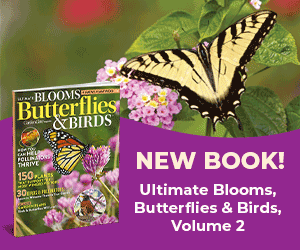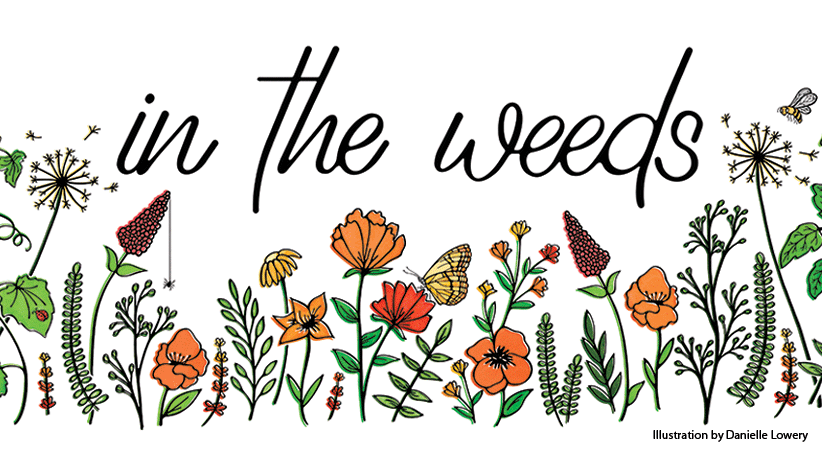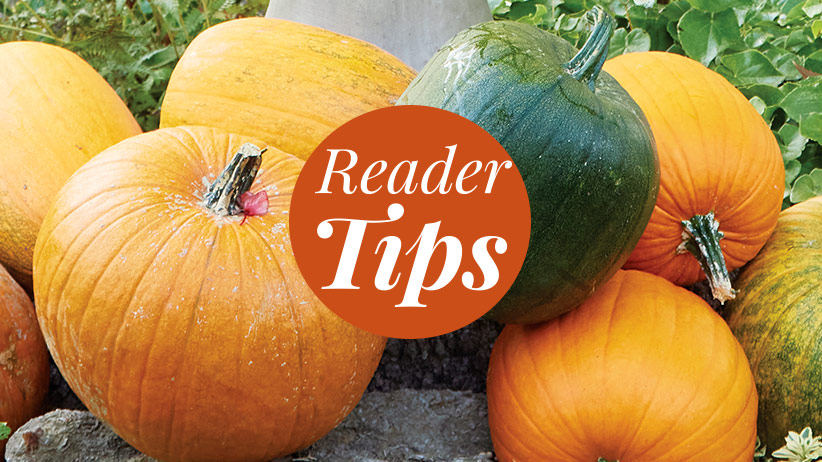The Giving Garden
Walk through Sue and Bob Olson’s Mankato, Minnesota, garden, and you’ll find just as many stories as you’ll find plants. Connections to other people are the heart of this ½-acre garden. For example, Sue says, “My brother built this shed for me about 15 years ago. I love it because it’s his handiwork.” Nearly every plant and ornament here carries a memory or a tie to a friend, family member or experience. This is why we chose the Olsons as this year’s Reader Garden Award grand prize winners. Congratulations to this creative gardening couple! Now let’s take a tour and hear their stories. Watch the Talk & Tour video above to get a feel for this impressive garden from our visit in August.
Meet This Year’s Reader Garden Award Runners-Up!
Lonna Engel's Painted Leaf Hosta Garden in Williamsport, PA
Becky Short from Macungie, PA
Enter Your Garden for a Chance to Win Next Year!

How the garden began
When Sue and Bob moved to Mankato and purchased this zone 5 property 26 years ago, the backyard was all lawn except for a perennial-filled island bed in need of renovation. Sue had grown up in a family of gardeners and always kept a garden as an adult. So she knew that it was better to watch the existing beds for a season to get to know the property before she started executing all of her backyard dreams.

When they did dig into the perennial bed project, they found Siberian iris (Iris sibirica), garden phlox (Phlox paniculata), daylilies (Hemerocallis spp. and hybrids), purple coneflowers (Echinacea purpurea) and many other Midwestern stalwarts. Sue says, “I kept as much as I could but cleaned that bed up and spread the plants around.”
You Might Also Like:
This or That: Black-eyed Susan vs. Purple Coneflower
How to Divide 45 Common Perennials
Garden Design Collection

An ever-evolving garden
They raised their children in this house and now welcome grandchildren to visit. Once she had more time to garden, Sue really ramped up the outdoor projects, and every spring she and Bob seem to add another element to the backyard. (The latest project is a series of raised beds filled with cut flowers at the back of the garden.) You can see in the overhead view that the plantings extend around the backyard’s perimeter and surround the house, incorporating the 8×12-foot garden shed as well as several raised vegetable and flower beds. Over time, the couple has learned how to protect plantings from deer that live in the wooded area at the back of the property and how to keep a garden colorful from spring through fall.

A welcoming space
The property slopes down from front to back: The second-story floor-to-ceiling windows overlooking their patio creates almost a bird’s-eye view of the backyard from the couple’s living room. It’s a year-round show. In warmer weather, they enjoy eating alfresco on the lower patio, which has two dining sets that accommodate their growing family. Up a few steps, visitors can retire to a comfortable lounge area complete with the wood-burning fireplace above, perfect for cool evenings in spring and fall.
As all gardens do, this one has evolved. In the early years here, the couple dined on an upper-level deck and had a hot tub on the nearby patio. Over time, habits and space usage changed. When entertaining became a bigger priority, they removed the hot tub, renovated that patio and added the fireplace. Then Sue and Bob built a second patio large enough to comfortably accommodate a group.
Of course the Olsons enjoy entertaining in their backyard, but this isn’t the only way they create memories and connect with people in the garden. Experiences with friends and family have contributed to the garden’s décor and design as well.
Thanks to Jung Seed for providing a $500 gift card to our grand prize winner!
Work + Play
The Olsons don’t only host guests on their patios for leisure time. Every spring, family and friends gather with their wheelbarrows for a mulch party to help transport 42 cubic yards of shredded wood mulch from a single pile in the driveway to several smaller ones around the backyard. Sue provides the food and drinks, and Bob spends the next 10 days spreading the mulch throughout the beds.

A Garden Full of Mementos & Memories
Beds and borders throughout this backyard are filled with reminders of loved ones and different experiences. Several years ago Bob drove three hours with his car’s hatchback open to bring home the pew in the photo above from his childhood church. (On this trip he learned that if he turned the music volume high enough, he could drown out the dinging trunk alarm!) Sue painted a favorite quote on it and sealed it with Gronomics™ Cedar Garden Bed Oil to protect it.
She says, “We used to carry every ornament and pot indoors every fall. But we got to the point that we couldn’t do that anymore.” She felt emboldened to leave glazed containers outdoors when she saw that a nearby nursery left their stock out in winter. Now the couple empties the pots, turns them upside down and leaves them where they stand. Sue says that they haven’t lost one to winter damage yet.

Custom mosaic art
This colorful mosaic is made on window frames that Sue saved from Bob’s grandmother’s house. She has a few of these “stained glass” windows positioned throughout the garden and plans to store them indoors in winter.
You Might Also Like:
DIY Garden Project Ideas
Classic Woodworking Project Plans
Watch Our Videos on YouTube!
Reflections of Life in the Garden

Viking-themed garden bed
When they establish a new garden bed, the couple often adds meaningful mementos. For example, Bob finally talked Sue into purchasing a football-shaped stepping stone a few years ago with the agreement that he would maintain the part of the garden where it was displayed. He leaned into his love for the Minnesota Vikings NFL team, and planted a Velvet Viking™ Japanese maple among purple and gold plants, including the annual angelonias (Angelonia angustifolia) planted in a “V” shape in the photo above. He even planted a ‘Cheesehead’ potentilla (Potentilla fruticosa) nearby as a nod to the classic Vikings-Packers rivalry.

A special butterfly garden
Ten years ago, Sue was diagnosed with breast cancer in April. She says, “I knew what I was faced with, but I didn’t want to let my gardens go. So I threw myself into the yard that spring.” As she was working the night before treatments began, a butterfly landed on her again and again. She says, “In that moment, I knew everything would be OK.” She later added some butterfly ornaments in the area where she was working to remind her of the peace the butterfly brought her that day.

Family memories
And when Sue’s dad passed away, they planted the river birch (Betula nigra) above in his memory and added owl statuary beneath it. Sue says, “We always said Dad was the wise owl of the family.”

Plants Connect People
Gardening is a family pastime. In fact, many members of Sue’s extended family grow pieces of the same bearded iris (Iris hybrids), peony (Paeonia lactiflora) and clematis (Clematis spp. and hybrids) passed down from her great-grandparents’ garden. And her dad “kept gardening until he absolutely couldn’t do it anymore. Then he loved to come here and give me ideas.”
Sharing the plant love
Receiving and sharing divisions has been a key part of the garden’s success. Filling these large beds wouldn’t have happened as quickly without pass-along plants from other gardeners. Not only is this a budget-friendly way to acquire plants, it’s also a good way to find those that you know will thrive. If they’re already doing well in a neighbor’s garden, you know they’ll survive your particular climate’s challenges. (Just do a bit of research before accepting divisions. Sometimes well-meaning friends share plants that are a little too aggressive!)

Friends have passed along speedwell (Veronica hybrid), more bearded iris, tall sedum (Hylotelephium spp. and hybrids) and garden mums (Chrysanthemum spp. and hybrids). They even have a division of the old-fashioned bleeding heart (Lamprocapnos spectabilis) that Bob’s mother received from a friend when he was born.
Annual spring plant division
Every spring, Bob and Sue grab their spades and look for perennials that are spreading too far or are overcrowded and need rejuvenation. Some go into new beds on their own property, but they plant the rest into recycled nursery pots in preparation for a giveaway. At this annual spring event, they set 250 or more potted plants onto the driveway and put out a call to gardeners in their neighborhood and in local social media groups, offering free plants.
Sue says, “We love the idea of our passion being shared and nurtured, and we hope that some of it will be paid forward.” It’s a fun way to connect with old friends and make new ones (and a good way to recycle those ubiquitous plastic nursery pots, which often make their way back to the Olsons to be refilled another year!).

Lasting garden labels
To keep track of plants for herself and visitors in this ever-expanding garden, Sue inserts the Wren stainless steel plant markers you see above near most perennials. She writes the plant name on the front of the tag and important details, such as its size, who gave it to her and the year it was last divided, on the back with a paint pen.

The Keys to Long-Lasting Color
Because the view of the backyard is so prominent from inside the house, it’s important that it has year-round interest. Sue has achieved this by mixing hardscaping, ornaments and a variety of different types of plants. You can see the effect in the photo above.
An artist’s perspective in the garden
In many gardens, even with careful planning, there are lulls between bloom times throughout the growing season. But not here. Sue says, “I’m always paying attention to where I need more color. Will this spot need more purple when this plant fades? Do I need more yellow here?” The flower show begins with daffodils (Narcissus spp. and hybrids), grape hyacinths (Muscari armeniacum), peonies and Siberian irises in spring, and ends with garden mums and New England asters (Symphyotrichum novae-angliae) in late fall.

Better with begonias
Ribbons and splashes of annual begonias (Begonia hybrids) like those in the photo above knit the garden together. Sue loves them because they’re so easy to grow, “and they give you a lot of wow factor!” She buys several flats and pots of varieties in the Dragon Wing® and Big® series (especially those with bronze leaves) every spring. And she also tries several new varieties every year.

Multiplying begonias
She plants begonias in containers and in clusters along border edges, and throughout the growing season, she pinches back new plants regularly to encourage branching and more flowers. Instead of tossing the cutoff stems into the compost pile, she strips off the lower leaves, dips the ends in rooting hormone and plants each cutting in the soil wherever she sees a hole. The photo above shows what a new cutting looks like — spindly at first, but with some extra water and a bit of time, it will grow. By the end of the summer, she has a garden full of begonias.
Before the first frost, she cuts some plants back, pots them up and sets the pots on a shelf in the basement with no lights. They lie dormant until late winter, when she starts to water regularly. Sue says, “You’d swear that they’re deader than dead, but they come back every year.” Come spring, she begins taking cuttings again so she has plenty of little begonias to jump-start the year.
Meet Our Previous Reader Garden Award Winners
- Multiseason Beauty With Perennials & Flowering Trees
- Grand Garden Experiment
- Charming Southern Backyard Garden
- Beautiful Hillside Garden
- Urban Garden Retreat

Pest Patrol in the Garden
A few years ago, Sue and Bob installed a 6-foot-tall aluminum fence around the perimeter of the backyard to keep deer out of the garden. But like many of us, they still struggled with rabbit damage. Over the years, they’ve sprayed vulnerable plants with Liquid Fence® Deer and Rabbit Repellent in spring and caged shrubs in winter to deter nibbling critters. But as the garden grew, these extra chores became too tedious to manage.

Backyard protection
Eventually they discovered that planting vegetables and cut flowers in 17- to 32-inch-tall Vego Metal Raised Garden Beds made them difficult for bunnies to access. This year, Bob purchased 700 feet of 2-foot-high fencing and used plastic ties to secure it to the bottom of the fence, extending to soil level. So far, it’s kept rabbits from entering the garden. He knows that he’ll have to patrol regularly to check for vulnerable spots and secure loose areas in the fence. Since the backyard is the only fenced part of the property, they’re still spraying and caging the unprotected front yard plants.
You Might Also Like:
11 Deer and Rabbit Resistant Plants for Your Garden
Shrubs Deer Won't Eat
Deer-Resistant Perennial Garden Plan
“Count the bunnies”
Sue acknowledges that even though the rabbits frustrate her, she thinks they’re cute and has a large tongue-in-cheek collection of rabbit ornaments scattered throughout the beds (check out a few examples below). “Count the bunnies” is a fun game to play with grandchildren. Congratulations to Sue and Bob for earning the Reader Garden Award title this year. We’re so glad they shared it with us!















